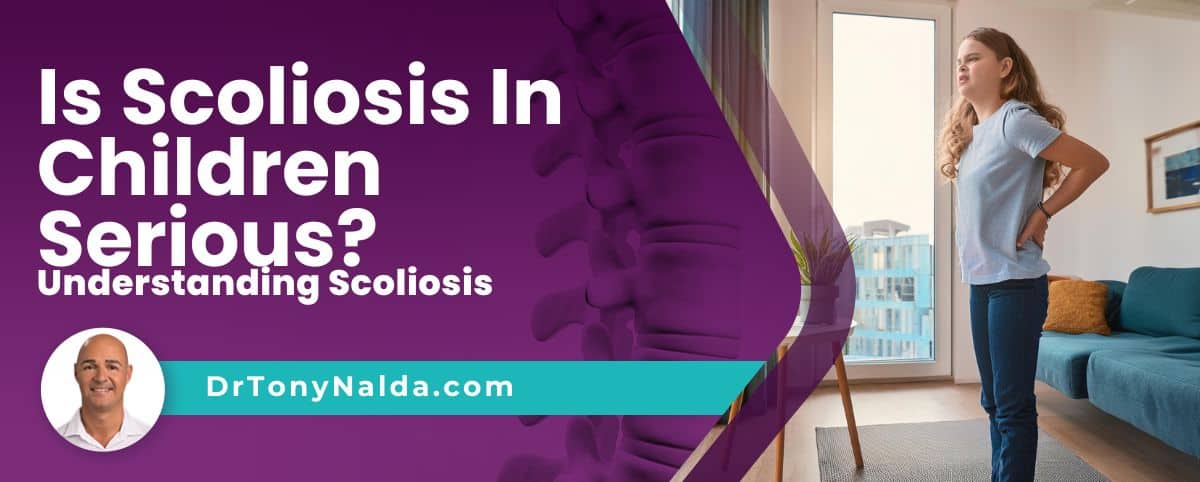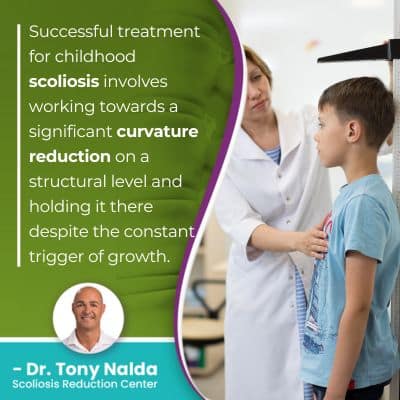Is Scoliosis In Children Serious? Understanding Scoliosis

Scoliosis affects all ages, but as it's most often diagnosed in children, many consider it to be a childhood condition. Scoliosis can affect babies, infants, juveniles, and adolescents. The most prevalent form of scoliosis overall is adolescent idiopathic scoliosis, diagnosed between the ages of 10 and 18
Scoliosis is an important condition for parents and/or caregivers to understand; it's the leading spinal condition among school-aged children and as a progressive condition triggered by growth, childhood scoliosis should always be taken seriously.
What's most important to understand about scoliosis is the benefit of early detection and intervention.
Table of Contents
Early Detection of Scoliosis
Scoliosis is diagnosed through a combined physical examination that includes taking a patient's medical history and family history, and performing what's known as an Adam's forward bend test.
An Adam's forward bend test is the gold standard of scoliosis screening exams and involves a patient bending forward in front of me while I examine their spine and trunk.
In a forward-bend position, the spine, along with any related trunk asymmetries, are highly visible, and postural asymmetries to look for include uneven shoulders, uneven hips, an uneven waistline, and the development of a rib cage arch.
When combined with the use of a Scoliometer, I can also determine a patient's angle of trunk rotation (ATR).
To diagnose scoliosis, an unnatural sideways bending spinal curve with a minimum Cobb angle measurement of at least 10 degrees, and rotation, has to be present, and this is determined through a scoliosis X-ray.
There are never treatment guarantees, but with early diagnosis and intervention, there are fewer limits to what can be achieved, and this is because as a progressive condition, the nature of scoliosis is to get worse over time, and this means the size of the unnatural spinal curve is going to increase, as are the condition's uneven forces, and their effects.
When detected early, treatment can be started earlier, and the milder scoliosis is, the simpler it is to treat, and this is where progression comes in, and when it comes to treating childhood scoliosis especially, counteracting progression.
Childhood Scoliosis Progression
 In most cases of childhood scoliosis, the cause is unknown, and idiopathic scoliosis is the most common type to affect all ages, and while we don't always know what causes the initial onset of scoliosis in children, we do know what makes them progress: growth.
In most cases of childhood scoliosis, the cause is unknown, and idiopathic scoliosis is the most common type to affect all ages, and while we don't always know what causes the initial onset of scoliosis in children, we do know what makes them progress: growth.
A child's spine is constantly growing, and as growth spurts can trigger the curve to get larger and more complex to treat, the more progression occurs, the more noticeable its effects tend to be, and in children, this involves postural changes.
Oftentimes, the earliest signs of scoliosis in children are uneven shoulders, one shoulder blade protruding more on one side than the other, uneven hips, the development of a rib cage arch, arms and legs that appear to hang at different lengths, and in addition to postural changes, signs of scoliosis to watch for also include changes to balance, coordination, and gait.
When it comes to the condition's most-prevalent type, adolescent idiopathic scoliosis, this age group is the most at risk for rapid phase progression because of the rapid and unpredictable growth spurts of puberty.
Scoliosis progression can happen quickly, and once it does, a child's spine becomes more unhealthy and a child's treatment becomes more complex; in most cases, it's more effective to proactively work towards preventing progression than it is to attempt to reverse the effects of progression once they're established.
Successful treatment for childhood scoliosis involves working towards a significant curvature reduction on a structural level and holding it there despite the constant trigger of growth.
So as we've discussed the most common type of childhood scoliosis, let's address the other age groups that are affected starting with babies born with scoliosis.
Congenital Scoliosis
Babies are born with congenital scoliosis, and it's a rare form affecting approximately 1 in 10,000 babies.
Congenital scoliosis should always be taken seriously as it's caused by the development of a malformed spine that occurs in utero; babies born with congenital scoliosis have to be comprehensively assessed as they often present with additional congenital abnormalities.
Infantile Scoliosis
Infantile scoliosis can be idiopathic and is diagnosed between the ages of 6 months and 3 years of age.
While some cases of infantile scoliosis resolve on their own and don't progress with growth, it's impossible to tell which will and which won't, so treatment for infantile scoliosis should also be taken seriously.
Early-Onset Juvenile Scoliosis
Early onset scoliosis in juveniles is diagnosed between the ages of 3 and 10, and this is the age group I can make the biggest impact with treatment as they have not yet had their first pubescent growth spurt.
Taking mild juvenile scoliosis seriously can mean avoiding juveniles progressing into adolescence, a stage of growth that puts them more at risk for rapid progression.
When diagnosed early before significant growth spurts start, there is more time to work towards impacting conditions on multiple levels, and when it comes to conservative chiropractic-centered treatment, a child's doctor can design a customized treatment plan that addresses the severity of the curve, along with the current rate of progression.
All Types of Childhood Scoliosis Need Treatment
Regardless of scoliosis severity or type, all children with scoliosis should be getting treatment; while early detection and intervention doesn't guarantee treatment success, it does make it more likely.
As a child's spine is still growing, progression is always a risk, and while there is a chance that some cases of childhood scoliosis won't progress with growth, as a progressive condition, virtually all cases are going to get worse at some point, hence the importance of proactive treatment.
 In children, growth spurts cause progression which causes the size and rotation of the unnatural spinal curve to get larger, along with the postural changes it causes, and disruptions to movement.
In children, growth spurts cause progression which causes the size and rotation of the unnatural spinal curve to get larger, along with the postural changes it causes, and disruptions to movement.
As a progressive condition, where a child's scoliosis is at the time of diagnosis doesn't mean that's where it will stay, and the best time to start treatment is always now; conditions are simpler to treat the milder they are, and the sooner treatment is started, the less likely it is that invasive surgical treatment will be needed in the future.
When it comes to a proactive conservative treatment approach, this involves integrating multiple scoliosis-specific forms of treatment capable of impacting conditions on every level.
Chiropractic care can work towards adjusting the position of the curve's most-tilted vertebrae so a curvature reduction can be achieved on a structural level.
Physical therapy and scoliosis-specific exercises can help increase core strength so the spine is optimally supported, stabilized, and posture is improved.
Corrective bracing is particularly effective on growing spines so is a regular facet of childhood scoliosis treatment.
Rehabilitation can involve continued chiropractic care to hold the reduction and the prescription of a series of scoliosis-specific exercises that can easily be performed from home to further heal and stabilize the spine.
Conclusion
Although scoliosis is incurable and progressive, it can be highly manageable, and the earlier scoliosis is diagnosed and treated, the more likely the spine is to respond well.
As scoliosis progresses, the condition's effects not only become more pronounced, but the spine also gets increasingly rigid, making it less responsive to treatment and harder to perform certain therapeutic exercises as part of treatment.
When childhood scoliosis is left untreated, it can progress unimpeded, become severe, and for those on the path of traditional scoliosis treatment, this is when spinal fusion surgery is commonly recommended.
Spinal fusion is an invasive, costly, and risky procedure that involves fusing the curve's most-tilted vertebrae into one solid bone and attaching metal rods to the spine to hold it in place.
While fusing the spine can help keep it straight and stop it from progressing, the way it does so is contrary to the spine's natural movement-based design and can cost the spine in terms of its overall flexibility and range of motion; for young adults, this can greatly impact quality of life, particularly for young athletes.
Scoliosis develops in children of all ages, and it progresses as a child grows; as scoliosis doesn't become a compressive condition until skeletal maturity has been reached, scoliosis effects in children don't commonly include back and/or radiating pain.
So is scoliosis in children serious? Yes, all severity levels and types of scoliosis are serious, but childhood scoliosis can be more serious because its progression is triggered by growth.
Here at the Scoliosis Reduction Center, I take all cases of childhood scoliosis seriously.
Dr. Tony Nalda
DOCTOR OF CHIROPRACTIC
After receiving an undergraduate degree in psychology and his Doctorate of Chiropractic from Life University, Dr. Nalda settled in Celebration, Florida and proceeded to build one of Central Florida’s most successful chiropractic clinics.
His experience with patients suffering from scoliosis, and the confusion and frustration they faced, led him to seek a specialty in scoliosis care. In 2006 he completed his Intensive Care Certification from CLEAR Institute, a leading scoliosis educational and certification center.
About Dr. Tony Nalda
 Ready to explore scoliosis treatment? Contact Us Now
Ready to explore scoliosis treatment? Contact Us Now





